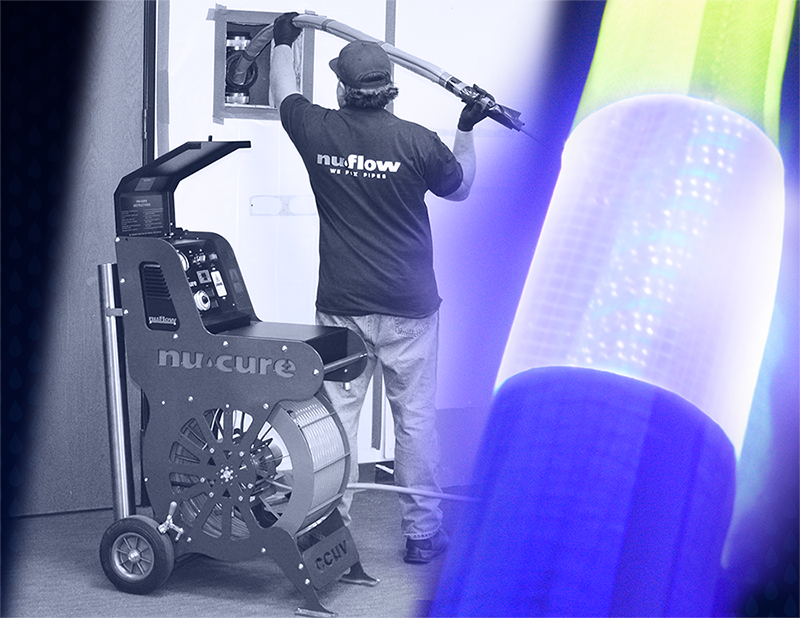Small diameter pipe repair
While industry attention is often focused on pipelines outside the building, lining technologies have been proving their worth rehabilitating the untold kilometers of pipes found inside the building envelope for decades. Rehabilitating the intricate drain pipe network inside the building, including pipe as small as 4cm (1.5”) with multiple bends, puts a spotlight on the installation processes used.
Pull-In-Place vs Inversion
Light curing, of course, is a leap forward in CIPP lining, improving consistency in the final product, speeding installation times, lowering technician labor costs, and lowering risk by enhancing control over the lining process relative to ambient cure of a two-part epoxy. In-building lining installation techniques, whether light cured or not, utilize either an inversion process or a push- or pull-in-place (PIP) method. Precision PIP (Push or Pull-in-Place) installation methods with integrated inflation bladders have been specifically developed for the small diameter, inside the building, and under slab market, whereas most other CIPP installation methods were developed and optimized for the volume utility sector, with long lengths of larger diameter pipes.
The combination of push- or pull-in-place and UV curing is an especially compelling rehabilitation solution. The virtually unlimited resin pot life and the ability to wet out liners well in advance and off-site, for example, ensures that technicians utilizing UV curing are not racing the clock in the way they are when working with a two-part epoxy, since curing does not start until the lights are illuminated. The critical benefit of UV lining with push- pull-in-place, says NuFlow Certified Contractor Mike Lomonaco is the precision that can be maintained and “…the way you can double check your work, and verify tie-ins. There’s no loud equipment, so the working environment is calm and not rushed. Pull in place is the way to go.”
Added Frank Rucco, from NuFlow Certified Contractor Pipe Restoration Solutions, “…the risk factor on jobs dropped substantially, because we have more control over the curing process.”
In the smallest diameter pipes, robotic reinstatement at remote branch connections is not always practical or even possible, and the overlapping of connection liners at a reinstated service connection can result in an excessive reduction of the inside diameter. Precision push- or pull-in-place gives the option of “gapping” (or leaving the branch connection, wye or tee, un-lined) or utilizing connection profiles (connection liners) to achieve a total lining system in applications where other processes would resort to more disruptive and costly measures, including additional excavation. With time-sensitive installations, the option of gapping would allow for an immediate return to service without having to wait for the much longer process of robotic connection reinstatements. If desired, connection profiles for the branch connections can be independently installed during a separate phase of the work.
Precision Placement
NuFlow’s Precision PIP installation methods, which allows for monitoring and precise placement with a CIPP camera, easily avoids under-shots or over-shots during liner insertion (absolutely critical when lining “blind shot” branch pipes) and ensures that joints and fittings near the end of the liner are properly sealed with extremely precise and reliable placement. One advantage of NuFlow’s NuDrain and NuCure Cold Cure UV CIPP liners is that they achieve a full-length, full-area tight frictional interface seal, rather than relying upon local end-seals that can actually damage the structure of a CIPP liner. Hydrophilic seals will periodically leak unless kept continuously wet, and while small intermittent leakage may be considered acceptable for exterior buried utility work, only zero leakage is acceptable inside of a building footprint (especially above ground).
Inversion is not capable of such precision placement and is also at higher risk when installing through multiple bends. Furthermore, inversion comes with the risk of stretching during installation and a likelihood of air pressure “burps” disruptively blowing out traps and releasing aerosolized contaminants into the buildings. And liner products certified for plumbing use inside of the building envelope must also be free of VOCs and Hazardous Air Pollutants, a requirement the bulk of the CIPP products used in the exterior utility sector do not meet. NuFlow tube design permits better negotiation of bends (which tend to be more frequent in plumbing and mechanical piping) with less risk of twisting and excessive wrinkling and with a more consistent as-built structural wall thickness.
In UV curing installations, Resin Protection Systems are designed to prevent premature curing of the resin, allowing for as much time as necessary to position the liner precisely, and enables the outer thermoplastic coating to properly contain and protect the resin, helping avoid bleed-out, wash-out, and emulsification during insertion and curing. The inflation bladder also avoids resin blow out which can lead to CIPP liner wall leaks, which frequently happen when other processes experience inner film pinholes or seam failures. Containing the resin also greatly reduces the risks associated with uncured resin left within the building envelope (especially where missing host pipe sections can result in extensive resin bleed off).
Cold Cure UV
In-building rehab also involves jobsite footprint considerations. A true “cold cure” refers to a low peak exotherm and a short exotherm duration, resulting in minimal excess heat. Cold curing is energy efficient, but just as importantly, doesn’t require additional active cooling techniques or equipment. Curing processes that require active cooling are typically more expensive than cold curing, and can depend on bulky equipment which increases the jobsite footprint and presents challenges in smaller, in-building work areas.
When exposure to light controls the cure, the variable site conditions have far less influence and crews need to make fewer site-specific method adjustments, so cold cure light curing results in a much more consistent cure across installations. Paired with a precision push- or pull in-place installation method, CIPP is very much at home inside the building.
What baking cookies tells us about light curing
NuCure CCUV Shines with Benefits
